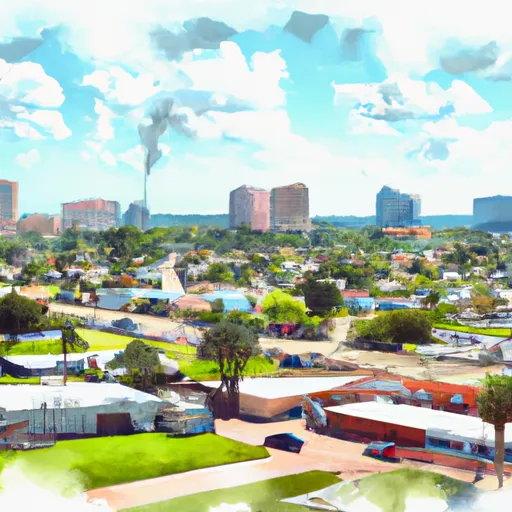-
 Snoflo Premium
Snoflo Premium
Get unlimited access to all our content
With no Ad interruptions! - Start Your Free Trial Login with existing account
Largo
Eden Index
Climate
6.6
•
Recreation
4.2
•
Community
3.1
•
Safeguard
4.9/10

Largo, Florida is a vibrant city located in Pinellas County, on the Gulf Coast of Florida. Known for its warm and tropical climate, Largo experiences hot and humid summers with temperatures averaging in the high 80s (Fahrenheit) and mild winters with temperatures in the 60s. The area enjoys abundant sunshine throughout the year, making it ideal for outdoor activities.
Largo is surrounded by several bodies of water, including the Intracoastal Waterway and the Gulf of Mexico. The hydrology constituents in the area consist of numerous lakes, ponds, and wetlands. Additionally, the city is home to the beautiful McKay Creek, which is a popular spot for fishing and kayaking. The creek is also part of the extensive Pinellas Trail, offering a scenic route for walking, biking, and jogging.
Outdoor enthusiasts in Largo can take advantage of the many recreational opportunities available. Largo Central Park is a favorite destination for picnicking, walking trails, and attending concerts and events. Highland Recreation Complex offers facilities for swimming, tennis, basketball, and other sports. The nearby Gulf beaches provide opportunities for swimming, sunbathing, and water sports like paddleboarding and jet skiing. Overall, Largo, Florida offers a delightful climate and diverse hydrology constituents, making it a haven for outdoor recreation.
What is the Eden Index?
The Snoflo Eden Index serves as a comprehensive rating system for regions, evaluating their desirability through a holistic assessment of climate health, outdoor recreation opportunities, and natural disaster risk, acknowledging the profound impact of these factors on livability and well-being.
Climate Health Indicator (CHI): 6.6
Largo receives approximately
1324mm of rain per year,
with humidity levels near 86%
and air temperatures averaging around
23°C.
Largo has a plant hardyness factor of
10, meaning
plants and agriculture in this region tend to thrive here all year round.
By considering the ideal temperature range, reliable water supplies, clean air, and stable seasonal rain or snowpacks, the Climate Health Indicator (CHI) underscores the significance of a healthy climate as the foundation for quality living.
A healthy climate is paramount for ensuring a high quality of life and livability in a region, fostering both physical well-being and environmental harmony. This can be characterized by ideal temperatures, reliable access to water supplies, clean air, and consistent seasonal rain or snowpacks.
Weather Forecast
Streamflow Conditions
Tampa Bay
Area Rivers
Tampa Bay
Snowpack Depths
Tampa Bay
Reservoir Storage Capacity
Tampa Bay
Groundwater Levels
Recreational Opportunity Index (ROI): 4.2
The Recreational Opportunity Index (ROI) recognizes the value of outdoor recreational options, such as parks, hiking trails, camping sites, and fishing spots, while acknowledging that climate plays a pivotal role in ensuring the comfort and consistency of these experiences.
Access to outdoor recreational opportunities, encompassing activities such as parks, hiking, camping, and fishing, is crucial for overall well-being, and the climate plays a pivotal role in enabling and enhancing these experiences, ensuring that individuals can engage in nature-based activities comfortably and consistently.
Camping Areas
| Campground | Campsites | Reservations | Toilets | Showers | Elevation |
|---|---|---|---|---|---|
| Fort Desoto County Park | 238 | 3 ft | |||
| Manatee Springs State Park | None | 25 ft | |||
| Hinton Landing County Park | None | 19 ft | |||
| Otter Springs County Park | 100 | 19 ft |
Nearby Fishing
Catastrophe Safeguard Index (CSI):
The Catastrophe Safeguard Index (CSI) recognizes that natural disaster risk, encompassing floods, fires, hurricanes, and tornadoes, can drastically affect safety and the overall appeal of an area.
The level of natural disaster risk in a region significantly affects safety and the overall livability, with climate change amplifying these risks by potentially increasing the frequency and intensity of events like floods, fires, hurricanes, and tornadoes, thereby posing substantial challenges to community resilience and well-being.
Community Resilience Indicator (CRI): 3.1
The Community Resilience Indicator (CRI) recognizes that education, healthcare, and socioeconomics are crucial to the well-being of a region. The CRI acknowledges the profound impact of these elements on residents' overall quality of life. By evaluating educational resources, healthcare accessibility, and economic inclusivity, the index captures the essential aspects that contribute to a thriving community, fostering resident satisfaction, equity, and social cohesion.

